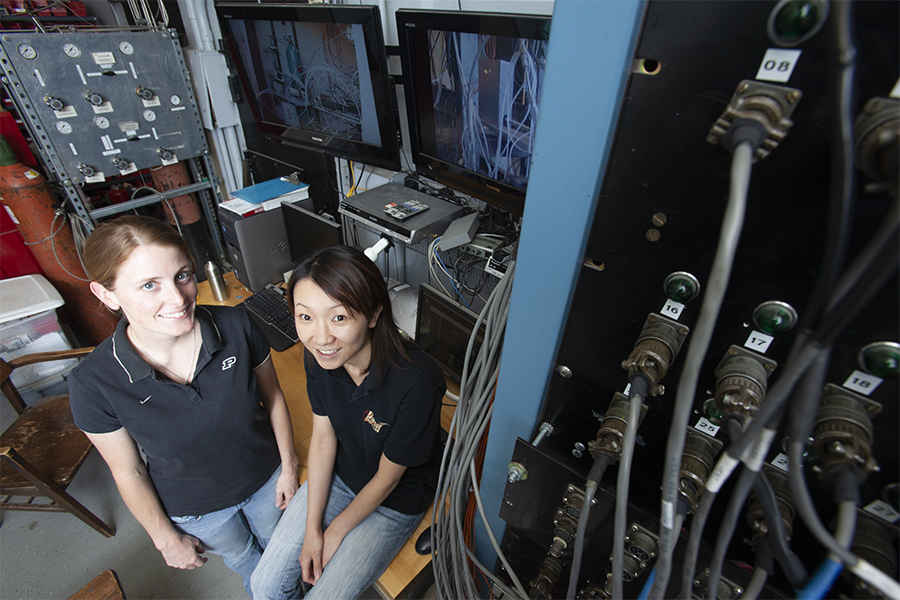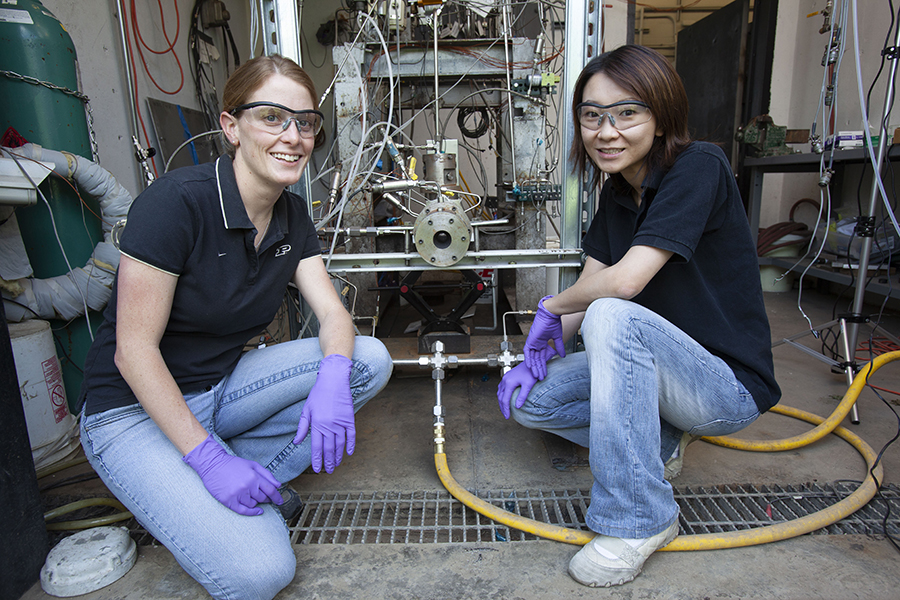Class of 2020 OAEs Matsutomi, O'Hara built bond at Purdue

Could have been any Friday night in 2008.
Yen Yu and fiancé Yu Matsutomi squeezed around a table with fellow School of Aeronautics and Astronautics graduate student Loral O’Hara making dumplings, with Loral dialed in, getting the folds just-so, filling the pockets with engineer-type efficiency.
They talked about their hometowns, their families, their goals and their failures. They laughed ’til their faces hurt and their sides prickled, Loral throwing in what Yen calls “composed sarcasm without a flinch,” and playful Yen mixing in self-deprecating humor. Then they said good night, with an expectation of seeing each other again soon.
Purdue University’s Maurice J. Zucrow Laboratories may have felt like home base back then, so focused were Yen and Loral on tackling combustion instability in liquid rocket engines. But Yen’s and Yu’s apartment was a nice change-of-pace, for stories beyond what advisor William Anderson requested of them in the lab, for lives to intertwine, interests to be shared, bonds to form.
When Yen and Loral finished their studies at Purdue, Yen with a Ph.D. after already receiving a bachelor’s and master’s from AAE, and Loral with a master’s, in 2009, they separated and pursued passions on opposite sides of the country. Yen went to Washington to join Blue Origin; Loral to Massachusetts and Woods Hole Oceanographic Institute.
In the decade-plus since, they’ve kept in touch, relaying news about a promotion, an award or an exciting research opportunity. But in phone calls or visits, they’ve been more likely to talk about their lives outside of work. And meeting in person always is preferred. They’ve met up in Washington, D.C., to tour the U.S. Capitol and Smithsonian Museums. They’ve connected in the Pacific Northwest to ski. While in Cape Cod, Loral gave Yen’s family a tour of the 25-foot sailboat she lived on and WHOI’s submersible Alvin.

Talk always comes easily, hugs come swiftly and firmly, smiles come broadly and frequently, and laughs go belly-deep and last longer. The foundation of the friendship may have been established through an intense environment of graduate school in an aerospace engineering field surrounded primarily by men, but the deepening of the friendship developed through respect, like-mindedness and love.
No wonder it’s special for these two women to be selected as Outstanding Aerospace Engineers in the same class.
They can celebrate together, all of the work that started in the School of Aeronautics and Astronautics, the foundation built that propelled them into impressive careers: Yen as senior director of the Engines Design Office that supports all Blue Engines programs, leading an organization with more than 350 employees; and Loral now among NASA’s astronaut corps after an accomplished eight-year career at WHOI.
None of it surprised Anderson, the graduate advisor to both.
“It’s an even more interesting story than if they were to come together and follow the same path. They came together and took very different and very remarkable paths,” said Anderson, who nominated both for the AAE’s highest alumni honor and will introduce both during the OAE virtual ceremony April 12. “In both cases, they’re both so brave and so willing to do things.
“Yen will do anything. She’s the first one out to try something new, whether it’s an intellectual endeavor or physical, snowboarding, skiing. If she’s never done it before, she wants to try it. In that sense, they’re very much alike. Loral is always ready to go, too. But Loral is really quiet. It’s a bit misleading because she’s got an enormous amount of self confidence, and she knows what she wants.”
Anderson is the one who initially connected the pair.
When a new student comes to his research group, Anderson typically assigns a mentor. Yen already had been established, doing her master’s work with Anderson before starting her Ph.D. in 2005. When Loral was looking to choose her research topic — she initially came to AAE as a direct-Ph.D. student but switched to a master’s path — she said all of Anderson’s projects were interesting. When combustion instability in liquid rocket engines ended up the focus, Anderson paired Loral with Yen because Yen was “the expert on it,” he said.
Yen and Loral became the first all-female rocket propulsion team at Zucrow Labs, Anderson said, and, at the time, they formed one of the few all-female rocket propulsion teams in the country.
They conducted subscale rocket engine experiments for NASA’s Marshall Space Flight Center. Yen built a model rocket, and for each test, the pair measured temperature and pressure under different configurations, injector sizes, combustor sizes, operating chamber pressure and other propellant combinations. The goal: To establish predictive capability and gain fundamental understanding toward rocket engine combustion instability that could be applied to next-generation rocket engines.

While working together at Zucrow, they co-authored a pair of conference papers: “A Vortex Shedding-Based Combustion Response Model Applied to an Unstable Liquid Rocket Combustor” and “Experimental Study of High-Frequency Combustion Instability in a Continuously Variable Resonance Combustor (CVRC).” The latter was a series of longitudinal combustion instability experiments that provided “beneficial information for numerical simulation,” according to another paper.
Over the two-plus years Loral worked with Yen, her admiration grew.
Yen was incredibly patient, willing to stop and teach and always made time to help. There was never pressure communicated about the importance of the work being done — Anderson later would call Yen’s Ph.D. work a “landmark experiment for the entire propulsion department at Purdue.”
“She’s just so matter of fact about it. You would never know talking to her that she’s a brilliant engineer,” Loral said of Yen’s humility. “I kind of ping-ponged around in my own interests so much, I very much admire people who can dive into a subject and study it with such intent.”
Yen’s experiment had several derivative experiments from it, and Loral’s experiments were a subset of that. Yen trained Loral on the experimental setup, explained how to use the analytical model Yen had developed and how to run the experiment.
The “buddy system” to operate experiments in the lab meant Loral was Yen’s buddy for her experiment and Yen was Loral’s buddy for hers. Loral’s experiment used Yen’s setup but Loral ran the condition and analyzed the condition to study her objectives.
Yen was impressed with Loral’s willingness to be hands-on — especially because Loral “always had stuff going on.”
“When I was in grad school, it was experiment, research and nothing else. You go home and you sleep. She was just constantly doing one thing and then the other, bicycling, hiking. She was also the first student that I’ve known who had chickens as pets and brewed home beer,” Yen said with a laugh. “She worked hard at the lab, so it was surprising you could still find time to do all these other things.
“She was telling me she signed up to be one of the few researchers out in Antarctica. She was going through selections for that (while at Purdue) and describing to me what that life would be or what the research would be. I seriously thought she was joking. She went after it anyway.”
Neither had any doubt the success that would come after Purdue — for the other.
Having witnessed Yen’s dogged determination and relentless pursuit of excellence, Loral knew Yen would impress with technical prowess and leadership ability.
“Even at Purdue as a Ph.D. student, she was just a good role model and a leader in our lab. Overall, the kind of person you’d want to put in charge of a lot of people and run a program,” Loral said. “She’s just really impressive.”
Yen actually tried to recruit Loral to Blue Origin, but Loral was fully immersed in the astronaut application interview process, for which she’d ultimately be selected.
“When it was announced, it wasn’t a surprise to me,” Yen said of Loral’s selection to the 2017 astronaut class. “I’ve heard so many people say, ‘I want to be an astronaut.’ But Loral is somebody I’ve seen that actually applied and did all the skill-building to get there.
“I’m so thrilled for her and so proud.”

